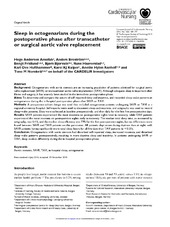| dc.contributor.author | Amofah, Hege Andersen | en_US |
| dc.contributor.author | Brostrøm, Anders | en_US |
| dc.contributor.author | Fridlund, Bengt Gotthard Anton | en_US |
| dc.contributor.author | Bjorvatn, Bjørn | en_US |
| dc.contributor.author | Haaverstad, Rune | en_US |
| dc.contributor.author | Hufthammer, Karl Ove | en_US |
| dc.contributor.author | Kuiper, Karel Kier-Jan | en_US |
| dc.contributor.author | Ranhoff, Anette Hylen | en_US |
| dc.contributor.author | Norekvål, Tone M. | en_US |
| dc.date.accessioned | 2016-12-16T10:09:54Z | |
| dc.date.available | 2016-12-16T10:09:54Z | |
| dc.date.issued | 2016-04 | |
| dc.Published | European Journal of Cardiovascular Nursing 2016, 15(2):168-177 | eng |
| dc.identifier.issn | 1474-5151 | |
| dc.identifier.uri | https://hdl.handle.net/1956/15248 | |
| dc.description.abstract | Background: Octogenarians with aortic stenosis are an increasing population of patients admitted for surgical aortic valve replacement (SAVR) or transcatheter aortic valve implantation (TAVI). Although adequate sleep is important after illness and surgery, it has scarcely been studied in the immediate postoperative phase. Aims: To determine and compare the nature of self-reported sleep and insomnia, and recorded sleep–wake patterns in octogenarians during the in-hospital postoperative phase after SAVR or TAVI. Methods: A prospective cohort design was used that included octogenarian patients undergoing SAVR or TAVI at a regional university hospital. Self-reports were used to document sleep and insomnia, and actigraphy was used to record sleep–wake patterns. Data were collected at baseline preoperatively, and then daily for the first five postoperative days. Results: SAVR patients experienced the most insomnia on postoperative nights later in recovery, while TAVI patients experienced the most insomnia on postoperative nights early in recovery. The median total sleep time, as measured by actigraphy, was 6.4 h, and the median sleep efficiency was 79% for the five postoperative nights, but no differences were found between SAVR and TAVI patients on this parameter. All patients slept more during daytime than at night, with SAVR patients having significantly more total sleep hours for all five days than TAVI patients (p < 0.01). Conclusion: Octogenarians with aortic stenosis had disturbed self-reported sleep, increased insomnia, and disturbed sleep–wake patterns postoperatively, resulting in more daytime sleep and inactivity. In patients undergoing SAVR or TAVI, sleep evolves differently during the in-hospital postoperative phase. | en_US |
| dc.language.iso | eng | eng |
| dc.publisher | Sage | eng |
| dc.rights | Attribution CC BY-NC | eng |
| dc.rights.uri | http://creativecommons.org/licenses/by-nc/4.0/ | eng |
| dc.subject | Aortic stenosis | eng |
| dc.subject | SAVR | eng |
| dc.subject | TAVI | eng |
| dc.subject | in-hospital sleep | eng |
| dc.subject | octogenarian | eng |
| dc.title | Sleep in octogenarians during the postoperative phase after transcatheter or surgical aortic valve replacement | en_US |
| dc.type | Peer reviewed | |
| dc.type | Journal article | |
| dc.date.updated | 2016-11-04T09:17:39Z | |
| dc.description.version | publishedVersion | en_US |
| dc.rights.holder | Copyright 2015 The European Society of Cardiology | |
| dc.identifier.doi | https://doi.org/10.1177/1474515115620992 | |
| dc.identifier.cristin | 1374130 | |

